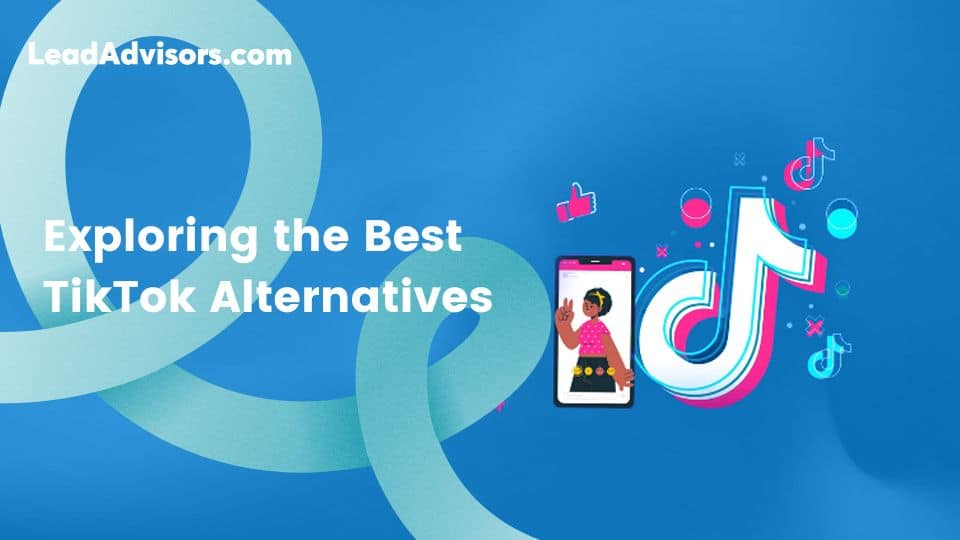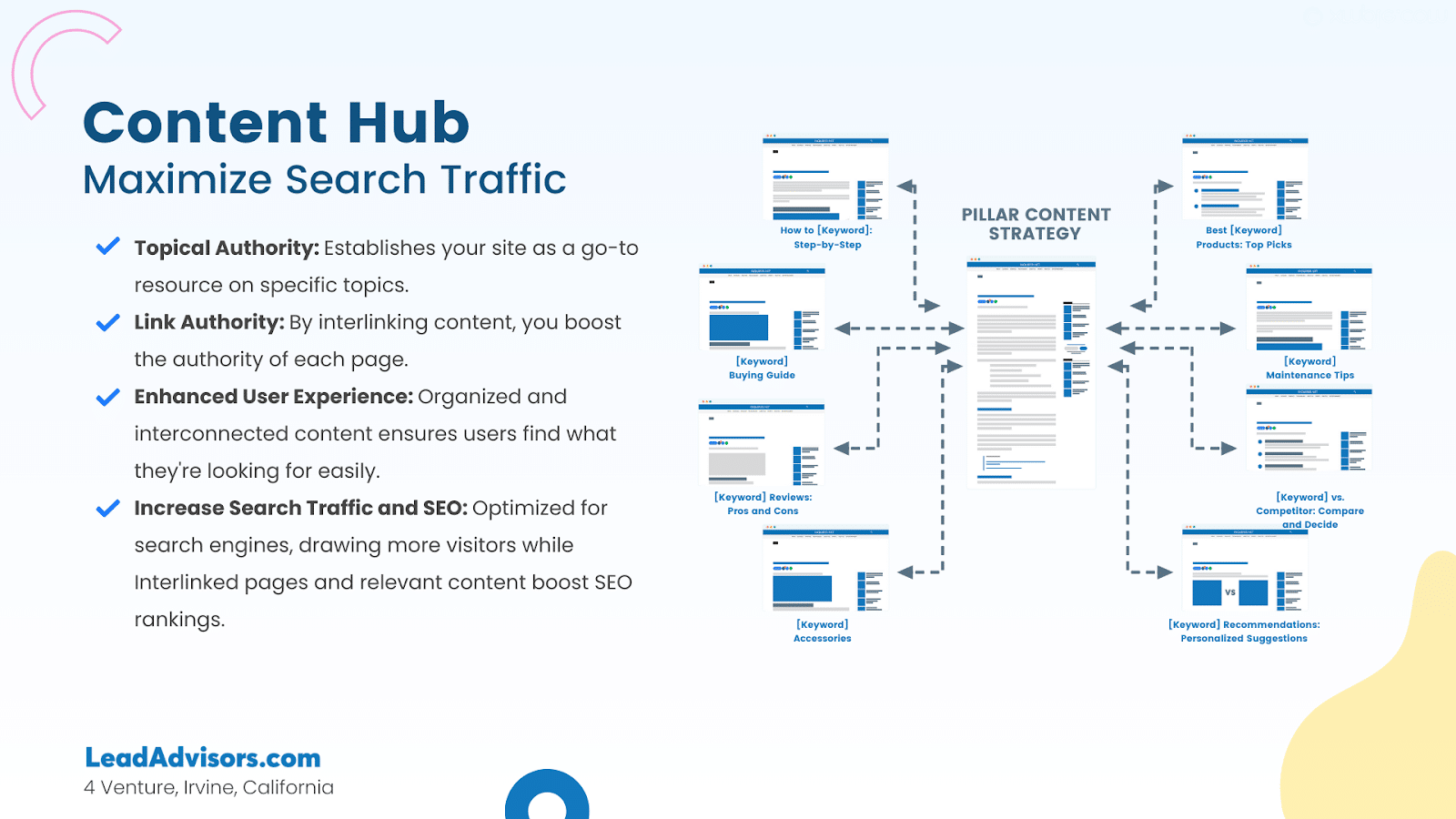The social media industry has grown to be a major player in the world economy. It allows every individual to create a profile for their business, project or to keep in touch with friends. Whatever you may be using your social media platform for, the fact is this: social media allows you to connect with billions of people around the world, which offers extreme opportunities for any personal venture.
The main question is, how do you successfully use social media to garner more traffic and increase your follower base?
Don’t worry; LeadAdvisors has you covered! Stay tuned while we outline the essential steps to creating the best social media marketing plan.
What is a Social Media Marketing Strategy?
A social media marketing strategy outlines your goals, methods, and action plan to ensure your time has tangible benefits to your brand or business.
It helps you make sure that you understand what the goals are, your strategies, and your action plan to get tangible results, like brand awareness and more website traffic. It’s also useful when mapping out aspects of your social media marketing plans mentioned above. Finally, it can also help track and measure the strategies’ efficiency.
Spend less time on marketing and more on creating, get a quote now!
How to Start Marketing on Social Media
There are four components of marketing on social media: audit, develop, engage, and measure. We’ll take you through each step to ensure you understand each one.
Audit
The first stage is to understand your current social media environment. This stage includes:
1.1. Assessing your social media presence
1.2. Identifying gaps
1.3. Setting profiles
How to Create a Social Media Audit Template
Step 1. Find all your profiles on social media sites and who runs them. Address any content issues.
Create a spreadsheet and write down all the social networks you own and the owner for each.
Step 2. Use Google to find anyone using your brand. Go on Google and search for other social media profiles representing your company that you don’t own (imposters). Create a separate spreadsheet.
Step 3. Determine what social networks you want to focus on. Evaluate the needs for all your social media profiles and create a mission statement for each to share the company’s culture and company achievements
Align Your Goals for Your Social Media Strategy
This is a quick high-level map of your business goals. Translate your objectives into actual social objectives for your social media marketing success. Here’s how you align your goals:
If you want to drive Brand Awareness, Reach is something you should be interested in tracking. You might want to look at the comments and inbound links for Thought Leadership.
For Word of Mouth, you should look at the shares and retweets. For Leads, you’re going to use form fills for the most part. And for Sales, you need to look at the online purchase.
And, of course, form fills could lead to online purchases if you have the right nurture flow in place.
Read More: What Is a Marketing Strategy?
Set SMART Goals
Make sure your goals for your marketing strategy are SMART: Specific, Measurable, Attainable, Relevant, and Time-Based.
Avoid goals that only focus on vanity metrics, like Likes and Followers.
Align goals with department and overall business goals. You should have a social media discussion with your different departments about how these goals align and fit together. As a social media manager, or the person running the social media accounts of your company, you need to make sure it fits the needs of your different departments. They need to understand what you’re using social media for because you will be driving sales for the business.
Select the Right Social Media Platforms
Before you jump into creating a social media profile, it is wise to determine what you will be using the account for. Different social media platforms cater to different user needs. Twitter, for example, provides an easy way to spread text to Twitter users while it offers limited graphic functionality. Instagram is a great platform to share visual content. The user feed presents the material, and by using the proper hashtags, your content can reach the “Explore” page, a section where relevant content is displayed to users worldwide.
Instead of using every possible social media marketing platform out there, you are better off focusing your efforts on a few channels that result in consistent content creation and user interaction.
Of course, when choosing your ideal social media marketing platform, you need to choose the channel that caters to your ideal audience. Ask yourself, “What is the average demographic of my customer, and what platform are they most likely to use?” By keeping these questions in mind, you can narrow your focus to get real results on your social media marketing profile.
There are some excellent research tools open to the public. A great example is wearesocial.com, which supplies reports on global metrics and usage of different networks on social media.
Take a look at different social media networks and understand which ones are right for you.
You May Also Like: 9 Tips to Make Your Business Stand Out on Instagram
Learn from Leaders
- Listen to your followers and industry chatter to get inspiration from industry leaders, competitors, and clients.
- Look back at the best performing content.
- Gain feedback internally from other departments and from customers via a survey.
How to Improve Your Profile?
Every social profile must have the following:
- Bio / Description
-Insert link to website
-Contact Information
- Image
-Profile Picture, Cover Photo
-High resolution
-Maximum fit and dimension
- Insert SEO description of your business profile
4 Key Points Before Selecting Your Social Network Profiles:
- Understand your target audience (age, location, lifestyle). Knowing your audience demographics allows you to know more about your social media users.
- Make sure you know how social fits into your marketing program.
- Understand your tone and brand. How you want to appear to your audience is important. Brand affinity tends to happen when people can trust a brand, and brand trust comes with many factors.
- One factor is your tone staying consistent, which means you’re not erratic across the different social media platforms. Carry a brand voice that’s unique and authentic.
Develop
The second step is developing your social media marketing strategy and understanding what the key components are.
2.1. Set your goals
2.2. Select social networks
2.3. Build a content plan
Develop Content Strategy

- Does the material explain your market?
- Does the material answer important questions?
- Is the content attractive and share-worthy?
- Does the content tell your company’s story?
When you create content, you direct it to your ideal audience. Because of this, great material to provide can be industry-related information, industry secrets or innovations, walkthroughs or guides for a specific brand activity, and other company-related topics. Once you have a content strategy to work from, you should work on the next three steps:
- Identify the right content for your brand
- Create a content calendar
- Publishing content efficiently
How to decide on what content to post?
Brand Positioning and Tone of Voice
Like social media profiles, your brand’s tone and voice within your content are critical. You want to make sure that your brand’s voice is something users can pick up on and become familiar with. This is part of your brand that will stay with your audience.
Important Issues to The Brand
Think about other industry issues and topics that are happening. You might want to stay current in the news to understand what’s going on to make sure you can share some important information about the industry or your brands that’ll be relevant to your audience. Make sure you understand what your audience is looking for.
External Parties Referring Your Brand
Do some research, see what people are saying about your brand on the social media network, and understand whether it’s media industry experts or just reviews from your customers. You might find some really interesting nuggets that are surprising to you but will help you know how other people see your brand. Understanding this will help you steer your brand in the direction you’re looking to go or continue towards what it’s already known as.
Community Interests Outside of You and Your Brand
Post content around the interests of your audience beyond your specific product. Let’s think of an example. There’s this company named Vega, and they have nutritional products like protein powders, bars, and shakes. One of the things that they do is that they post lifestyle commentary. They do blog posts on “how to stay cool in the summer” or “how yoga helps the mind and the body.” Even though they’re selling nutritional products, they figured out the lifestyle category that their audience is in, so they post content around that.
Historical Performance of Content

Once you know which posts worked on your social media page, you can figure out what makes those posts compelling content.
Search Behavior
Take a look at what keyword searches in your category, and see what potential customers are looking for around your brand.
Contents Strategy – Rule of Thirds
As you create content for social media channels, the majority of content will likely fall into these three categories:
- Promote your products
- Share industry/lifestyle news
- Converse with customers
Even with these three categories, it can still be hard to keep up with a social media platform and publish content at a consistent pace. The best way to have a successful social media marketing plan is to plan a content calendar.
Creating A Content Calendar
While you technically can do social media marketing with little planning, it’s not the best way to use your time. With a content calendar, you can plan a blog post weeks, even months, in advance. You can even set up social media marketing campaigns that will help meet your goals.
Here are the first steps to creating a content calendar yourself:
- Decide on dates, time, author, audience, and social network
- Develop content topics
- Create “Call-to-action” in post
- Allocate content to different types of posts (example below)
Here are a few extra features and their benefits to remember when you create engaging content:
- 50% of content links back to the blog
- 25% curated from another source
- 20% drives content related to your business
- 5% is related to HR and company culture
Let’s look at a restaurant as an example for producing content on social media channels.
Every Monday, you can post weekend highlights. The Monday blues happen, so your social media followers are interested in what happened on the weekend. Tuesday, you might want to post a life hack tip. Wednesday is a feature of the week. Thursday, a recipe.
And Friday, a weekend buzz; what’s happening, what’s going to be exciting during the coming weekend.
There should be a thematic approach to your content that you can perform. You might want to stay regular with your social media posts. You’ll need to have a structure for it. This is just a restaurant example. It doesn’t mean you need to post every single day across all of your social networks.
To stay ahead of your competitors, you should research the tips on the frequency of posts depending on the social network that you’re using and what type of content you need to put out there.
Have a structure or template, so you don’t have to reinvent the wheel every week or two.
Related Article: How to Build A Social Media Plan
Visual Content Tools

- Canva – Canva is a graphics editor with an easy-to-use interface. The software provides an array of templates to fit your specific company theme. However, if you have the time and are more interested in the creation, Canva gives you the option to create custom content. Check out the Canva website here to see other features available.
- GIPHY – GIPHY is a great platform for both access to a variety of gifs and content creation. The service allows you to utilize and create GIFs that are great at drawing the attention of platform users. You can choose from a collection of photos, videos, and website URLs to combine and create GIF multimedia.
In the modern age of rapid information sharing and meme creation, GIPHY, linked here, is a great tool for custom content. Create some innovative material that will give insight into the ins and outs of your business or industry.
- Animoto – Animoto is another great business promotion tool that allows you to create visually appealing slideshows by combining photos, videos, and text excerpts. These slideshows, also known as storyboards, are available for custom creation and template formatting alike. Some of the built-in storyboard templates include seasonal promotions, how-to guides, advertisement space, and various business-specific options. Check out the Animoto website here, and try using the service to optimize your social media marketing venture.
Read More: Why is Content Marketing so Important for Your Business?
Engage

3.1. Setup workflow and processes involved
3.2. Publish and share
What is Engagement?
It simply means responding to your target market in a way that evokes a response. In social media, it can be a follow, like, or comment.
TIP: Use keywords to listen to the market and offer input, ideas, or content.
Publish Content Efficiently
- Manage all your social content in one place & share with teams
- Schedule your content daily
- Schedule pre-event posts
TIP: Set aside 15-30min a day to find a valuable post or post a valuable content.
Using Facebook Effectively
- Use images and video
- Use social media ads to reach a target audience – ie “lookalike audiences’
- Short text posts – favored by Facebook’s algorithm
- Clear call-to-action (CTA)
TIP: 2 posts per day is optimal for audience engagement.
Using Twitter
- Keep posts at least 20 characters under the 140 limit to allow for retweets and comments
- Pictures result in 35% more retweets
Using Linkedin
- Tagging companies or people that you are connected with adds authority to your posts; Just make sure they are related to the topic
- Engage your audience by asking relevant questions
Using Google+
- Sharing “How To” content has shown to perform very well
- Start using a hashtag for a campaign – keeps everyone turned into campaign
Measure

4.1. Identify metrics
4.2. Use social media management tools to measure progress
How to Measure?
- Select social media analytics tools, such as Google Analytics & Hootsuite Analytics. It helps you visualize how things are flowing for your social media marketing strategy.
- Use a URL shortener like Ow.ly to track who is clicking on your content and from what region/geo.
- Create a custom report and determine how frequently you will review social media metrics (weekly or monthly, for example).
- Optimize your strategy based on the insight you’ve gained from the data you’re tracking.
What to Measure?
- Best performing posts
- Engagement
- Traffic
Refine your Strategy
- What worked well and resonated with your audience?
- What didn’t work well?
- What learnings have you taken away?
- How can you refine goals for the next period or quarter?
By building momentum among your follower base and hosting different promotions or events, you can expand your brand’s sense of community. The more people know about your brand or company, the more likely they will share it with other people. By hosting events and providing consistent user interaction, you build community in your industry, resulting in extreme social media growth. Some of these tactics include:
Referrals

Surveys/ “Call to Action”
Oftentimes, you can get user feedback through the functionality of the social media marketing platform. This feedback can come in surveys, product reviews, or even just a comment. When you provoke the user to interact, you get feedback about your brand, usually with a question or an attractive deal.
This is extremely valuable, as you can see into the mind of your specific audience base. Even better, the user who interacts with your content is more likely to remember your brand or industry. Remember to be human in your interactions; users can tell when content is genuine and get annoyed if constantly bombarded by obnoxious marketing material.
You May Also Like: Smart Budgeting: How to Spend Your Social Media Advertising Budget
Q&As
What are the different types of social media marketing?
There are different kinds of social media marketing, each holding its unique benefits. Social media marketing includes content marketing, advertising and sponsorship, influencer marketing, paid media, reviews, and forum contributions, to name a few.
What is a social media marketing example?
Spotify’s ‘Year Wrapped’ and the hashtag #yearwrapped social media campaign are great examples of social media marketing. Spotify uses data to create playlists of songs users play throughout the year. The hashtag allows users on social media platforms to share their playlists with friends while promoting the brand.
Do I have to create a social media strategy myself?
You don’t have to lift a finger to start posting on social media! Content marketers and agencies like LeadAdvisors specialize in creating entertaining and built content to keep traffic coming to your digital marketing. Want to learn more about how we can help?
What are the best social media marketing platforms?
While Facebook, the largest social media platform, continues to be the go-to for social media websites, the right social media channels for you depend on your target audience and your goals for marketing on social media. You can create a successful social media marketing plan for any platform with dedication and time. Aside from using these, relying on an effective social media management tool can make the plan easier to execute.
What’s the difference between organic and paid marketing for social media?
Organic marketing is content created with no money to entice users. Paid social media marketing is when content is paid for to increase brand awareness for a larger audience. Whether you publish paid or organic content, make sure it meets your criteria to bring you success.
Related Article: Social Media Branding: The Ultimate Guide
Final Word
Creating a social media marketing strategy for your business is the best way to generate leads and increase brand awareness. From educational content to creating social media campaigns, social media platforms are easily accessible gateways to more views for content and more traffic to your brand.
Would you like help creating content? LeadAdvisors is a content marketing agency specializing in creating content that ranks high in engagement and views.

















